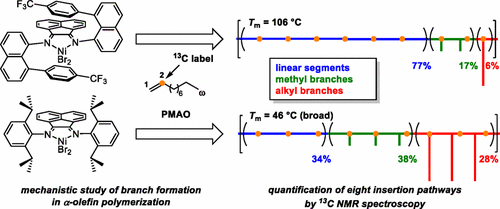当前位置:
X-MOL 学术
›
Macromolecules
›
论文详情
Our official English website, www.x-mol.net, welcomes your
feedback! (Note: you will need to create a separate account there.)
Understanding the Insertion Pathways and Chain Walking Mechanisms of α-Diimine Nickel Catalysts for α-Olefin Polymerization: A 13C NMR Spectroscopic Investigation
Macromolecules ( IF 5.1 ) Pub Date : 2017-09-07 00:00:00 , DOI: 10.1021/acs.macromol.7b01150 Kyle S. O’Connor 1 , Jessica R. Lamb 1 , Tulaza Vaidya 1 , Ivan Keresztes 1 , Kristine Klimovica 1, 2 , Anne M. LaPointe 1 , Olafs Daugulis 2 , Geoffrey W. Coates 1
Macromolecules ( IF 5.1 ) Pub Date : 2017-09-07 00:00:00 , DOI: 10.1021/acs.macromol.7b01150 Kyle S. O’Connor 1 , Jessica R. Lamb 1 , Tulaza Vaidya 1 , Ivan Keresztes 1 , Kristine Klimovica 1, 2 , Anne M. LaPointe 1 , Olafs Daugulis 2 , Geoffrey W. Coates 1
Affiliation

|
Nickel α-diimine catalysts have been previously shown to perform the chain straightening polymerization of α-olefins to produce materials with melting temperatures (Tm) similar to linear low density polyethylene (Tm = 100–113 °C). Branching defects due to mechanistic errors during the polymerization currently hinder access to high density polyethylene (Tm = 135 °C) from α-olefins. Understanding the intricacies of nickel α-diimine catalyzed α-olefin polymerization can lead to improved ligand designs that should allow production of chain-straightened polymers. We report a 13C NMR study of poly(α-olefins) produced from monomers with 13C-labeled carbons—specifically 1-decene with a 13C-label in the 2-position and 1-dodecene with a 13C-label in the ω-position—using a series of α-diimine nickel catalysts. Furthermore, we developed a mathematical model capable of quantifying the resulting 13C NMR data into eight unique insertion pathways: 2,1- or 1,2- insertion from the primary chain end position (1°), the penultimate chain end position (2p°), secondary positions on the polymer backbone (2°), and previously installed methyl groups (1m°). With this model, we accurately determined overall regiochemistry of insertion and overall preference for primary versus secondary insertion pathways using nickel catalysts under various conditions. Beyond this, our model provides the tools necessary for determining how ligand structure and polymerization conditions affect catalyst behavior for α-olefin polymerizations.
中文翻译:

了解用于α-烯烃聚合的α-二胺镍催化剂的插入途径和链行走机理:13 C NMR光谱研究
先前已证明镍α-二亚胺催化剂可进行α-烯烃的链伸直聚合反应,以生产具有类似于线性低密度聚乙烯(T m = 100–113°C)的熔融温度(T m)的材料。聚合过程中由于机械错误引起的支化缺陷目前阻碍了从α-烯烃获得高密度聚乙烯(T m = 135°C)。了解镍α-二亚胺催化的α-烯烃聚合反应的复杂性可以导致改进的配体设计,这应允许生产链伸直的聚合物。我们报告了由具有13种单体的单体生产的聚(α-烯烃)的13 C NMR研究使用一系列α-二亚胺镍催化剂,使用C标记的碳,特别是在2位带有13 C标记的1-癸烯和在ω位置带有13 C标记的1-十二碳。此外,我们开发了一种数学模型,该模型能够将所得的13 C NMR数据量化为八个唯一的插入途径:从主链末端位置(1°),倒数第二个链末端位置(2 p °),聚合物主链上的二级位置(2°)和先前安装的甲基(1 m °)。借助该模型,我们在各种条件下使用镍催化剂准确确定了整体的插入区域化学和对一级与二级插入途径的总体偏好。除此之外,我们的模型提供了确定配体结构和聚合条件如何影响α-烯烃聚合催化剂行为的必要工具。
更新日期:2017-09-07
中文翻译:

了解用于α-烯烃聚合的α-二胺镍催化剂的插入途径和链行走机理:13 C NMR光谱研究
先前已证明镍α-二亚胺催化剂可进行α-烯烃的链伸直聚合反应,以生产具有类似于线性低密度聚乙烯(T m = 100–113°C)的熔融温度(T m)的材料。聚合过程中由于机械错误引起的支化缺陷目前阻碍了从α-烯烃获得高密度聚乙烯(T m = 135°C)。了解镍α-二亚胺催化的α-烯烃聚合反应的复杂性可以导致改进的配体设计,这应允许生产链伸直的聚合物。我们报告了由具有13种单体的单体生产的聚(α-烯烃)的13 C NMR研究使用一系列α-二亚胺镍催化剂,使用C标记的碳,特别是在2位带有13 C标记的1-癸烯和在ω位置带有13 C标记的1-十二碳。此外,我们开发了一种数学模型,该模型能够将所得的13 C NMR数据量化为八个唯一的插入途径:从主链末端位置(1°),倒数第二个链末端位置(2 p °),聚合物主链上的二级位置(2°)和先前安装的甲基(1 m °)。借助该模型,我们在各种条件下使用镍催化剂准确确定了整体的插入区域化学和对一级与二级插入途径的总体偏好。除此之外,我们的模型提供了确定配体结构和聚合条件如何影响α-烯烃聚合催化剂行为的必要工具。









































 京公网安备 11010802027423号
京公网安备 11010802027423号